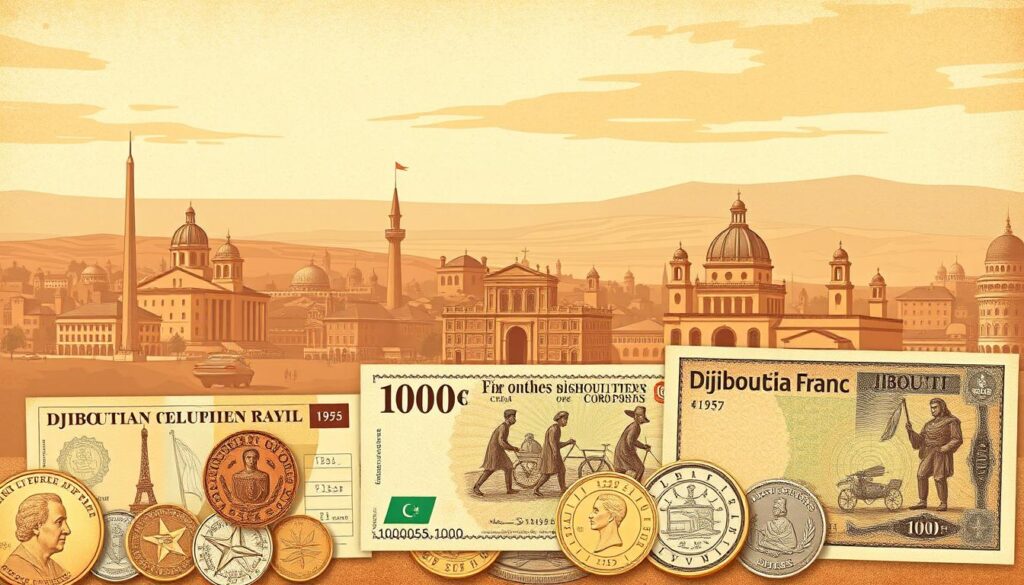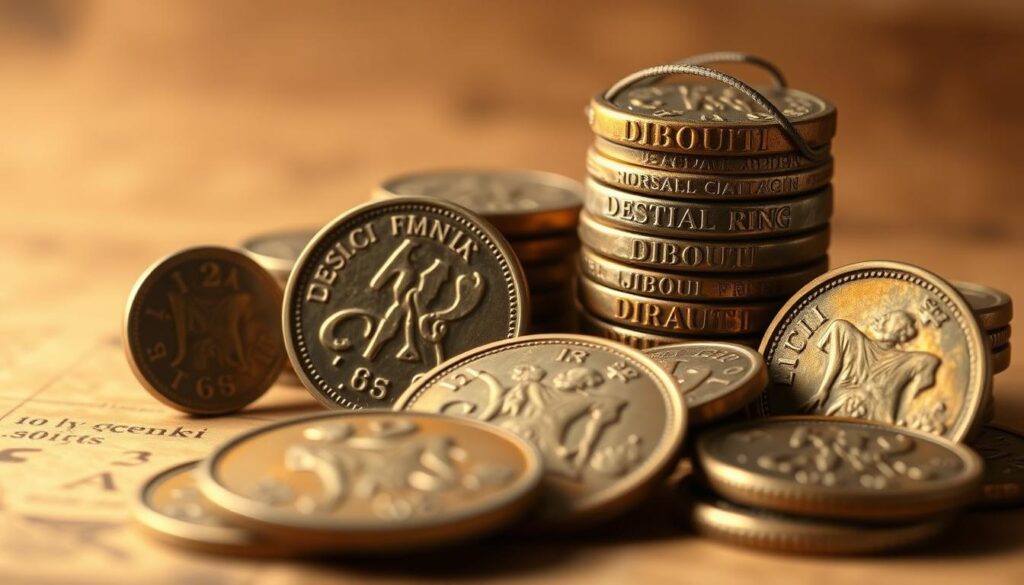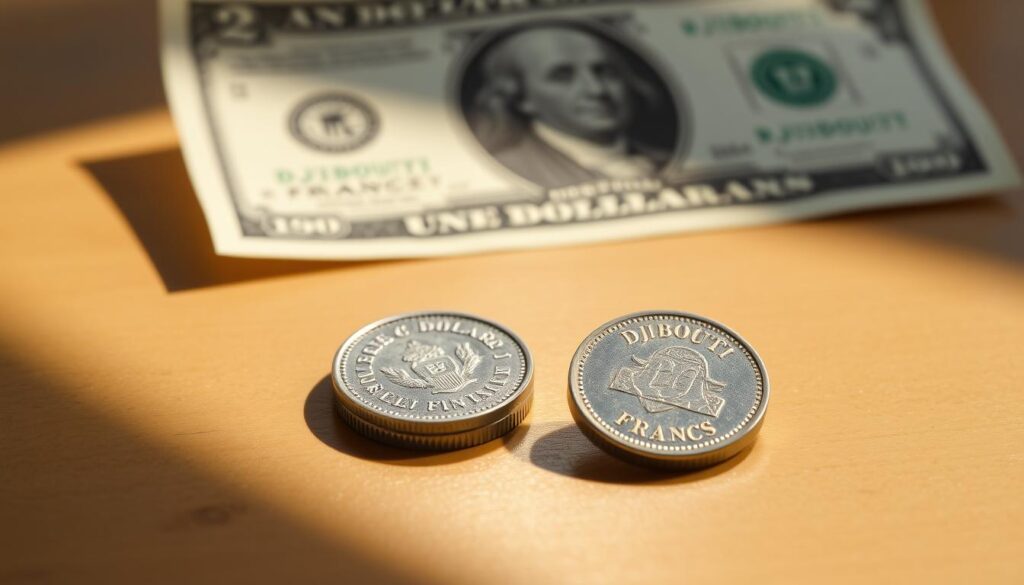
The Djiboutian franc was first used in 1949. It has been tied to the US dollar ever since. This move helped keep the economy stable, drawing in investors and boosting growth.
The Djiboutian franc has seen many changes over time. These changes show how the country’s economy and politics have grown. Knowing about the franc’s history helps us understand Djibouti’s role in the world economy.
Key Takeaways
- The Djiboutian franc was introduced in 1949.
- It has been pegged to the US dollar since its introduction.
- The currency has undergone several changes reflecting the country’s economic evolution.
- Understanding the Djiboutian franc’s history provides insights into Djibouti’s economic development.
- The currency’s stability has been a key factor in attracting investments.
The Origins of Currency in Djibouti
Djibouti has been a mix of cultures and currencies for centuries. Its location at the crossroads of Europe, Asia, and Africa made it a key trade hub. This shaped its currency history.
Pre-Colonial Trade and Monetary Systems
Before colonial times, Djibouti used different goods and currencies for trade. Goods like salt, livestock, and metals were exchanged. The ancient Djiboutian currency varied, showing the area’s diverse cultures.
Djibouti was a major trading center. It saw many currencies, from nearby and far-off lands. This set the stage for using foreign currencies later.
Early Foreign Currencies in the Region
Foreign currencies were used in Djibouti long before colonial times. The Indian rupee and Maria Theresa thaler were common. The Maria Theresa thaler was especially valued for its reliability and prestige.
The use of vintage Djibouti money and foreign currencies shows Djibouti’s role in trade. The variety of currencies also points to its importance as a trade crossroads.
Looking into Djibouti’s currency history, we see its unique cultural and geographical influences. The mix of currencies and trade networks has enriched Djibouti’s currency history.
French Somaliland Currency: The Precursor
The French franc’s introduction in Djibouti was a major shift in the area’s money history. As a French colony, Djibouti’s economy was closely linked to France. The French franc became the official currency, replacing earlier ways of exchanging goods and services.
Colonial Currency Introduction (1884-1949)
In 1884, the French franc was brought to Djibouti, then called French Somaliland. This was part of a plan to have one currency across French territories. The French franc brought stability to the local economy, making trade and economic ties with other French colonies easier.
The French franc’s use greatly impacted Djibouti’s economic growth. It made transactions simpler, reducing the hassle of dealing with many currencies. It also made Djibouti’s economy align with French money policies.
The French Colonial Franc
The French colonial franc was more than just money; it was a sign of French economic power in the area. Its introduction and use showed Djibouti’s integration into the French colonial economic system. The French colonial franc was key in shaping Djibouti’s money history, preparing the way for the Djiboutian franc.
The legacy of the French colonial franc is seen in today’s Djiboutian currency. Its design and security features mix French influence with local culture.
The move from the French franc to the Djiboutian franc was a big step towards Djibouti’s monetary freedom. Knowing this history helps us understand how Djibouti’s currency has evolved and its current money system.
Birth of the Djiboutian Franc
The Djiboutian franc was introduced in 1949, replacing the French Somaliland franc. This change was a big step for Djibouti. It showed the country’s move towards independence and self-rule.
Establishment of the Currency
The Djiboutian franc was created to show Djibouti’s financial freedom. It was set at a fixed rate with the US dollar. This policy has helped keep the economy stable.
Initial Exchange Rates and Value
The Djiboutian franc was first tied to the US dollar. This move was key for the country’s financial health. It helped keep stability and drew in foreign investors.
The table below shows how the Djiboutian franc’s value changed against the US dollar over time:
| Year | Exchange Rate (DJF/USD) | Notes |
|---|---|---|
| 1949 | 214.392 | Initial Exchange Rate |
| 1960 | 214.392 | Stable Rate |
| 1970 | 214.392 | Continued Stability |
The fixed exchange rate has been vital for Djibouti’s economy. It has made the country more appealing for trade and investment.
Djibouti Old Currency: Chronological Development
The history of Djibouti’s currency shows important changes and reforms. These changes reflect the country’s path to independence and economic growth.
The journey of Djibouti old currency started in the mid-20th century. The first notable series came out in the 1950s-1960s. It had unique designs and values typical of the colonial era.
1950s-1960s Series
In this time, the currency showed French colonial symbols. Djibouti was then known as French Somaliland. This series was a key step in setting up a standard money system.
1970s Pre-Independence Notes and Coins
The 1970s brought new money that hinted at Djibouti’s soon-to-be independence. These changes aimed to create a currency that showed the country’s unique identity.
As independence drew near, the currency changed even more. This set the stage for the money system after independence.
1977 Independence Currency Reforms
1977 was a big year for Djibouti, as it became independent from France. New banknotes and coins were introduced, showing the country’s freedom. The historical Djibouti currency from then is famous for its special designs and historical value.
The changes after independence not only updated the money’s look. They also showed the new nation’s economic goals and policies.
Notable Banknotes of Historical Djibouti
Historical Djibouti banknotes show the country’s past in a unique way. They have different designs and security features. These banknotes were more than money; they carried the nation’s culture.
Iconic Designs and Denominations
Djibouti’s banknotes feature iconic designs that highlight the country’s culture and landmarks. They come in various denominations for different transactions. Notable designs include national symbols, historical figures, and important buildings.
Each series of banknotes has its own unique look, making them collectible. For example, the 1977 independence series marked a big change in the country’s currency, showing its new freedom.
Security Features Evolution
The security of Djibouti’s banknotes has improved a lot over time. At first, they had simple features like watermarks and basic printing. But as fake money technology got better, so did the banknotes’ security.
Later series added advanced security features like holograms, security threads, and detailed watermarking. These features made the banknotes safer and more beautiful.
Cultural Symbolism in Banknote Artwork
The artwork on Djibouti’s banknotes is full of cultural symbols. It shows the country’s rich heritage. Designs often include traditional clothes, plants, and animals.
The use of cultural motifs in banknote design makes them more than just money. They tell the story of Djibouti’s history, culture, and values. This makes them valuable as collectibles that show the nation’s heritage.
Collectible Djibouti Coins Through History
Collecting Djibouti coins is a captivating hobby. It offers a chance to explore the country’s rich history and culture. You can find many rare and commemorative coins.

Rare and Valuable Coin Series
Djibouti has many coin series that collectors love. These coins are made from precious metals like silver and gold. They have different themes and designs.
The value of these coins depends on their rarity and condition. Some were made in small numbers, making them very valuable.
Commemorative Issues
Commemorative coins celebrate important events in Djibouti’s history. They have unique designs and are made in various metals.
These coins are not just for trading. They also honor the country’s heritage and achievements.
Metallurgical Changes Over Time
The materials used in Djibouti coins have changed a lot. At first, they were made from precious metals. But later, they started using base metals because of economic reasons.
This change shows how Djibouti’s economy and minting practices have evolved.
Economic Context of the Djiboutian Franc
To understand the Djiboutian Franc, we must look at its history and how its value has changed. This currency, Djibouti’s official money, has seen ups and downs due to different economic factors.
Currency Stability and Inflation Periods
The stability of the Djiboutian Franc is linked to Djibouti’s economic plans. The currency’s tie to the US dollar has been key in keeping it stable. Yet, the country has faced inflation, especially when times are tough.
Inflation rates have changed over time, affected by both local and global economic factors. The government tries to keep inflation in check while still growing the economy.
International Relations and Currency Value
Djibouti’s location and its international connections have greatly affected its currency’s value. The country’s role as a trade center and its ties with investors have helped keep the Franc stable.
The Franc’s value is also shaped by Djibouti’s economic bonds with other countries, especially France, because of their shared history.
| Year | Inflation Rate (%) | Currency Value (DJF/USD) |
|---|---|---|
| 2000 | 2.5 | 177.72 |
| 2010 | 4.8 | 177.72 |
| 2020 | 3.2 | 177.72 |
The table shows the Djiboutian Franc’s steady value against the US dollar, even with changes in inflation rates over time.
The USD Peg and Modern Monetary Policy
Djibouti pegged its currency to the US dollar in 1949. This move has shaped its economic policy. It has helped keep the currency stable and improved trade relations.
Establishment of the Dollar Peg
In 1949, the Djiboutian franc was tied to the US dollar at a fixed rate. This was done to stabilize the currency and attract investors. Over time, the rate has seen some adjustments.
This decision was a big step for Djibouti’s economy. It led to a more stable monetary policy. This stability has been key for the country’s growth.
Impact on Currency Stability
The USD peg has greatly helped the Djiboutian franc’s stability. By fixing the exchange rate, Djibouti controls inflation and keeps the economy stable. This stability attracts foreign investors, boosting the economy.
A fixed exchange rate regime can provide stability and predictability, which are essential for economic development.” – International Monetary Fund
This stability also makes trade easier for Djibouti. It’s especially helpful for countries that use the US dollar for international transactions.
Comparison with Other African Currency Systems
Djibouti’s currency peg is rare in Africa. Many countries have floating exchange rates or are in currency unions. Comparing these systems shows the pros and cons of Djibouti’s choice.
| Country | Currency Regime | Benefits |
|---|---|---|
| Djibouti | USD Peg | Stability, Predictability |
| South Africa | Floating Exchange Rate | Monetary Policy Independence |
| West African Monetary Union | Regional Currency (CFA Franc) | Economic Integration, Stability |
The table shows different currency systems in Africa. Djibouti’s peg offers stability, but other systems have their own benefits. These include monetary policy freedom or economic integration.

In conclusion, pegging the currency to the US dollar has been crucial for Djibouti’s monetary policy. The impact on stability and comparisons with other systems show the complexity of these decisions.
Numismatic Value of Vintage Djibouti Money
Djibouti’s old money is very popular among collectors. This is because of its historical value and rarity. The country’s unique culture and strategic location make its coins and notes special.
Collector’s Market for Djiboutian Currency
The market for Djiboutian currency is growing fast. This is because more people are interested in African coins and Djibouti’s history.
Collectors love the unique designs and the stories behind the money. The condition, rarity, and age of the items are what make them valuable.
Valuation Factors for Antique Djiboutian Coins
Several things affect how much antique Djiboutian coins are worth. These include:
- Rarity: The fewer coins there are, the more valuable they are.
- Condition: Coins that are in good shape are worth more.
- Age: Older coins are often more sought after.
- Historical significance: Coins tied to big historical events are very valuable.
Rarity Scale and Condition Grading
The rarity scale and condition grading are key in figuring out the value of Djiboutian coins and banknotes. A standard grading system helps everyone see the condition and realness of the money.
| Condition Grade | Description | Value Multiplier |
|---|---|---|
| Poor | Heavily worn, may be damaged | 0.5 |
| Fair | Visible wear, some details lost | 1 |
| Good | Some wear, but major details intact | 2 |
| Very Good | Minimal wear, most details preserved | 5 |
| Excellent | Minimal wear, all details sharp | 10 |
The table shows a basic grading scale and how it affects value. The value multiplier shows how condition changes the item’s worth.
Preservation of Djibouti’s Monetary Heritage
Keeping the history of Djibouti’s currency alive is key to understanding the nation’s culture. The monetary heritage shows the country’s economic, social, and political growth.
Museum Collections and Exhibitions
The Central Bank of Djibouti is vital in saving the country’s monetary history. It does this through its museum collections and exhibitions. These displays show old banknotes and coins, giving a glimpse into Djibouti’s currency evolution.
A numismatics expert once said,
“The preservation of currency is not just about keeping old banknotes and coins; it’s about understanding the economic and cultural context in which they were used.”
Digital Archives and Documentation
Digital archives are also crucial for saving Djibouti’s monetary heritage. They help document and share the country’s currency history. This makes it easier for more people to learn about it.
Digital platforms are important for preservation. They make historical currency data more accessible for research and education.
Cultural Significance in National Identity
Djibouti’s currency has a big role in its national identity. The designs and motifs on banknotes and coins show the country’s history and values. They connect people to their heritage.
Preserving Djibouti’s monetary heritage is more than just keeping artifacts. It’s about keeping the nation’s history alive. It ensures future generations can learn from and appreciate their cultural legacy.
Conclusion: The Legacy of Djibouti’s Historical Currency
The history of Djibouti’s currency shows the country’s economic and political growth. The Djiboutian franc is a symbol of national identity and stability. It offers a glimpse into the nation’s past, highlighting its culture and the effects of colonialism.
The design and security features of the Djiboutian franc reflect its legacy. Its peg to the US dollar has kept the currency stable, aiding the country’s economic growth. Knowing about Djibouti’s currency history helps us understand its cultural importance and role in the nation’s identity.
Efforts to preserve Djibouti’s monetary heritage are underway. Museums and digital archives keep the history of the Djiboutian franc alive. This ensures that the old currency remains a key part of the country’s history, showing its economic and cultural progress.
FAQ
What is the history of currency in Djibouti?
Djibouti’s currency history starts long before colonial times. Early on, they used foreign money like the Indian rupee and the Maria Theresa thaler. The French introduced the French colonial franc in 1884. Later, in 1949, the Djiboutian franc was created.
What was the significance of the French colonial franc in Djibouti?
Introduced in 1884, the French colonial franc became Djibouti’s official currency. It replaced earlier currencies and was key to the local economy during the French Somaliland period.
When was the Djiboutian franc introduced, and what was its initial exchange rate?
The Djiboutian franc started in 1949, pegged to the US dollar. This policy has kept the economy stable ever since.
What changes occurred in Djibouti’s currency after independence in 1977?
After gaining independence in 1977, Djibouti updated its currency. New designs and denominations showed the country’s growth and changes.
What are some notable features of historical Djibouti banknotes?
Djibouti’s old banknotes feature famous landmarks and cultural symbols. These designs, values, and security features have changed over time.
What makes Djibouti coins collectible?
Djibouti coins are rare and valuable, making them collectible. They’ve been made from metals like silver and gold. Each coin has unique themes and designs.
How has the USD peg impacted Djibouti’s monetary policy?
The USD peg has brought stability and helped trade. It has shaped Djibouti’s monetary policy. This has kept the currency stable and influenced comparisons with other African currencies.
What factors influence the numismatic value of vintage Djibouti money?
The value of old Djibouti money depends on rarity, condition, and the collector’s market. Rare and well-kept notes and coins are most sought after.
How is Djibouti’s monetary heritage preserved?
Djibouti’s monetary history is kept alive through museums, digital archives, and documentation. These efforts educate people about the country’s rich history and culture.
What is the cultural significance of the Djiboutian franc?
The Djiboutian franc symbolizes national identity and economic stability. It reflects Djibouti’s growth and cultural heritage.
What is the current status of the Djiboutian franc?
The Djiboutian franc remains the official currency, tied to the US dollar. This ensures economic stability and supports trade.

Adam G
This post was created by Adam G, a seasoned financial writer with a passion for explaining currency exchange and market movements
